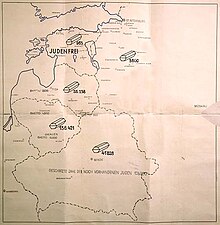
The Holocaust in Russia is the Nazi crimes during the occupation of Russia (Russian Soviet Federative Socialist Republic) by Nazi Germany.

The Holocaust in Russia is the Nazi crimes during the occupation of Russia (Russian Soviet Federative Socialist Republic) by Nazi Germany.
On 22 June 1941, Adolf Hitler abruptly broke the non−aggression pact and invaded the Soviet Union. The Soviet territories occupied by early 1942, including all of Belarus, Estonia, Latvia, Lithuania, Moldova, Ukraine and most Russian territory west of the line Leningrad–Moscow–Rostov, contained about four million Jews, including hundreds of thousands who had fled Poland in 1939. Despite the chaos of the Soviet retreat, some effort was made to evacuate Jews, who were either employed in the military industries or were family members of servicemen. Of 4 million about a million succeeded in escaping further east. The "Holocaust by bullet" was the task of SS death squads called Einsatzgruppen , under the overall command of Reinhard Heydrich. These had been used on a limited scale in Poland in 1939, but were now organized on a much larger scale. Most of their victims were defenseless Jewish civilians (not a single Einsatzgruppe member was killed in action during these operations). [1] They used their skills to become efficient killers, according to Michael Berenbaum. [2] By the end of 1941, however, the Einsatzgruppen had killed only 15 percent of the Jews in the occupied Soviet territories, and it was apparent that these methods could not be used to kill all the Jews of Europe. Even before the invasion of the Soviet Union, experiments with killing Jews in the back of vans using gas from the van's exhaust had been carried out, and when this proved too slow, more lethal gasses were tried. Units of the Wehrmacht also participated in many aspects of the Holocaust in Russia.
The Black Book of Soviet Jewry contains a section on occupied Russia, with testimonies about the Holocaust in Smolensk, Rostov-on-Don, Yessentuki, Kislovodsk and Stavropol among others.
It is estimated by some that before the war, 130,000 Jews lived in parts of the RSFSR that would be later be occupied. The majority evacuated eastward, and a report written by Einsatzgruppen mentions the massive flight. [3] Most of the Jews who remained in occupied RSFSR territories with the advance of the Wehrmacht were murdered by the beginning of 1942, except for some in the southern areas who were murdered between spring 1942 and winter 1942-1943. [4]
The YIVO encyclopedia places the number of Holocaust victims in the Russian Soviet Federated Socialist Republic at over 119,000. [5] This is because while much of the local Jewish population escaped, many refugees from places further west fled to these areas, only for them to be captured later. According to this source, most Holocaust victims in the RSFSR were murdered in the areas of Rostov-on-Don, Krasnodar, Smolensk and Bryansk.
The Nazi Genocide of the Jews carried by German Einsatzgruppen , and Wehrmacht along with local collaborators resulted in almost complete annihilation of the Jewish population over the entire territory temporarily occupied by Germany and its allies. [6] During World War II, Léon Poliakov established the Center of Contemporary Jewish Documentation (1943) and after the war, he assisted Edgar Faure at the Nuremberg Trial.
In July 1943, a Soviet military court in Krasnodar held the first war crimes trial of World War II. There were 11 defendants, all of whom were collaborators. They were each charged with treason for helping the Germans murder 7000 people during the occupation of Krasnodar. All but one of the defendants were members of the death squad Sonderkommando 10a, a subunit of Einsatzgruppe D. [7] [8]
All of the defendants pleaded guilty and begged for leniency. Eight of them were sentenced to death and publicly hanged on 18 July 1943, the day after sentencing. The other three were deemed to have had relatively minor roles and were instead each sentenced to 20 years of hard labour. While outside observers viewed the proceedings as a show trial, they did not doubt the severity or the extent of the crimes themselves, nor the guilt of the defendants. Observers said the true purpose of the trial was to showcase the suffering of Soviet civilians and deter further collaboration. [9] [10] [11]

Following the war, the Soviet Union suppressed or downplayed the impact of Nazi crimes on its Jewish citizens. An anti-Semitic campaign against "rootless cosmopolitans" (i.e. "Zionists") followed. On 12 August 1952, in the event known as the Night of the Murdered Poets, thirteen most prominent Yiddish writers, poets, actors and other intellectuals were executed on the orders of Joseph Stalin, among them Peretz Markish, Leib Kvitko, David Hofstein, Itzik Feffer and David Bergelson. [12]
The United States Holocaust Memorial Museum's Mandel Center's Initiative on the Holocaust in the Soviet Union works to gain a better understanding of this developing subfield and unearth the crimes and casualties. [13] The Mandel Center partnered with various international organizations such as the International Centre for History and Sociology of World War II and its Consequences at the National Research University Higher School of Economics, The Yiddish Language Institute, the Center for Judaic Studies at the University of Latvia, the Museum “Jews in Latvia", Taras Shevchenko National University of Kyiv, the Ukrainian Center for Holocaust Studies, and the National University of Kyiv-Mohyla Academy.

The Final Solution or the Final Solution to the Jewish Question was a Nazi plan for the genocide of individuals they defined as Jews during World War II. The "Final Solution to the Jewish question" was the official code name for the murder of all Jews within reach, which was not restricted to the European continent. This policy of deliberate and systematic genocide starting across German-occupied Europe was formulated in procedural and geopolitical terms by Nazi leadership in January 1942 at the Wannsee Conference held near Berlin, and culminated in the Holocaust, which saw the murder of 90% of Polish Jews, and two-thirds of the Jewish population of Europe.
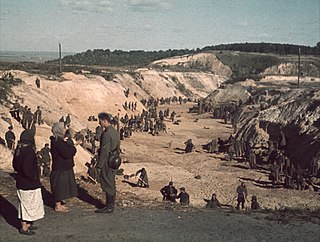
Babi Yar or Babyn Yar is a ravine in the Ukrainian capital Kyiv and a site of massacres carried out by Nazi Germany's forces during its campaign against the Soviet Union in World War II. The first and best documented of the massacres took place on 29–30 September 1941, in which some 33,771 Jews were murdered. Other victims of massacres at the site included Soviet prisoners of war, communists and Romani people. It is estimated that a total of between 100,000 and 150,000 people were murdered at Babi Yar during the German occupation.

Einsatzgruppen were Schutzstaffel (SS) paramilitary death squads of Nazi Germany that were responsible for mass murder, primarily by shooting, during World War II (1939–1945) in German-occupied Europe. The Einsatzgruppen had an integral role in the implementation of the so-called "Final Solution to the Jewish question" in territories conquered by Nazi Germany, and were involved in the murder of much of the intelligentsia and cultural elite of Poland, including members of the Catholic priesthood. Almost all of the people they murdered were civilians, beginning with the intelligentsia and swiftly progressing to Soviet political commissars, Jews, and Romani people, as well as actual or alleged partisans throughout Eastern Europe.
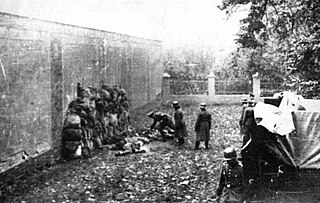
During World War II, the Nazi German Einsatzkommandos were a sub-group of the Einsatzgruppen – up to 3,000 men total – usually composed of 500–1,000 functionaries of the SS and Gestapo, whose mission was to exterminate Jews, Polish intellectuals, Romani, and communists in the captured territories often far behind the advancing German front. Einsatzkommandos, along with Sonderkommandos, were responsible for the systematic murder of Jews during the aftermath of Operation Barbarossa, the invasion of the Soviet Union. After the war, several commanders were tried in the Einsatzgruppen trial, convicted, and executed.

During World War II, the German Wehrmacht committed systematic war crimes, including massacres, mass rape, looting, the exploitation of forced labour, the murder of three million Soviet prisoners of war, and participated in the extermination of Jews. While the Nazi Party's own SS forces was the organization most responsible for the genocidal killing of the Holocaust, the regular armed forces of the Wehrmacht committed many war crimes of their own, particularly on the Eastern Front.

Martin Sandberger was a German SS functionary during the Nazi era and a convicted Holocaust perpetrator. He commanded Sonderkommando 1a of Einsatzgruppe A, as well as the Sicherheitspolizei and SD at the time of Nazi German occupation of Estonia during World War II. Sandberger perpetrated mass murder of the Jews in German-occupied Latvia and Estonia. He was also responsible for the arrest of Jews in Italy, and their deportation to Auschwitz concentration camp. Sandberger was the second-highest official of the Einsatzgruppe A to be tried and convicted. He was also the last-surviving defendant from the Nuremberg Military Tribunals.
The Geheime Feldpolizei, shortened to GFP, was the secret military police of the German Wehrmacht until the end of the Second World War (1945). Its units carried out plainclothes and undercover security work in the field. Their operations included clandestine operations, counterpropaganda, counterinsurgency, counterintelligence, creation of a counterinsurgency intelligence network, detection of treasonable activities, infiltration of resistance movements, gathering intelligence and destroying targets, protecting military installations, assisting the German Army (Heer) in courts-martial investigations, tracking and raiding targets to capture or kill, and setting-up security checkpoints in high-risk areas. GFP personnel, who were also classed as Abwehrpolizei, operated as an executive branch of the Abwehr, detecting resistance activity in Germany and in occupied France. They were also known to carry out torture and executions of prisoners.
The Holocaust in Belarus refers to the systematic extermination of Jews living in the Byelorussian Soviet Socialist Republic during its occupation by Nazi Germany in World War II. It is estimated that roughly 800,000 Belarusian Jews were murdered during the Holocaust. However, other estimates place the number of Jews killed between 500,000 and 550,000.

The Holocaust in Ukraine was the systematic mass murder of Jews in the Reichskommissariat Ukraine, the General Government, the Crimean General Government and some areas which were located to the East of Reichskommissariat Ukraine, in the Transnistria Governorate and Bessarabia, Northern Bukovina and the Hertsa region and Carpathian Ruthenia during World War II. The listed areas are currently parts of Ukraine.
The Holocaust in the Soviet Union was the Nazi German and Romanian persecution of Jews, Roma and homosexuals as part of the Holocaust in World War II. It may also refer to the Holocaust in the Baltic states, annexed by the Soviet Union before the start of Operation Barbarossa.
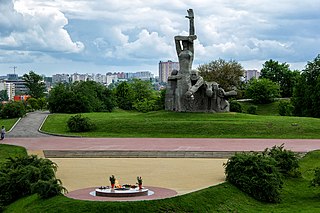
Zmievskaya Balka, Zmiyovskaya Balka is a site in Rostov-on-Don, Russia at which 27,000 Jews and Soviet civilians were massacred in 1942 to 1943 by the SS Einsatzgruppe D during the Holocaust in Russia. It is considered to be the largest single mass murder site of Jews on Russian territory during the Second World War. The name means "the ravine of the snakes".

The Bila Tserkva massacre was the mass murder of Jews, committed by the Nazi German Einsatzgruppe with the aid of Ukrainian auxiliaries, in Bila Tserkva, Soviet Ukraine, on August 21–22, 1941. When the Jewish adult population of Bila Tserkva was killed, several functionaries complained that some 90 Jewish children were left behind in an abandoned building, and had to be executed separately. The soldiers reported the matter to four chaplains of the Heer, who passed along their protests to Field Marshal von Reichenau; it was the only time during World War II that Wehrmacht chaplains tried to prevent an Einsatzgruppen massacre, but Paul Blobel's verbal order was direct and decisive.
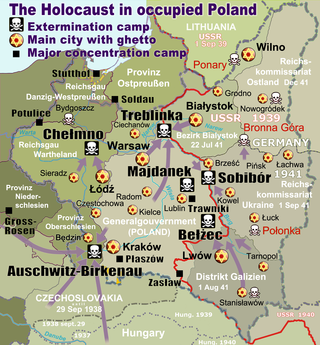
The Pińsk Ghetto was a Nazi ghetto created by Nazi Germany for the confinement of Jews living in the city of Pińsk, Western Belarus. Pińsk, located in eastern Poland, was occupied by the Red Army in 1939 and incorporated into the Byelorussian SSR. The city was captured by the Wehrmacht in Operation Barbarossa in July 1941; it was incorporated into the German Reichskommissariat Ukraine in autumn of 1941.
The Holocaust in Chachersk was the ghettoization and genocide of the Jews and Romani people mainly in the Belarusian shtetl of Chachersk, as well as in the greater Chachersk District located inside the Gomel Oblast during the Holocaust. Invading Soviet-controlled Belarus as a part of Operation Barbarossa, Nazi Germany subjected Chachersk and neighboring shtetls to systematic extermination. Entire Jewish and Romani populations in the region were rounded up in Nazi-organized ghettos and later murdered, in one of the earliest phases of the Final Solution.

The Einsatzgruppen Operational Situation Reports (OSRs), or ERM for the German: Die Ereignismeldung UdSSR, were dispatches of the Nazi death squads (Einsatzgruppen), which documented the progress of the Holocaust behind the German–Soviet frontier in the course of Operation Barbarossa, during World War II. The extant reports were sent between June 1941 and April 1942 to the Chief of the Security Police and the SD in Berlin, from the occupied eastern territories including modern-day Poland, Belarus, Ukraine, Russia, Moldova, and the Baltic Countries. During the Nuremberg War Crimes Trials the originals were grouped according to year and month and catalogued using a consecutive numbering system, as listed in the below table. The original photostats are held at the National Archives in Washington D.C.
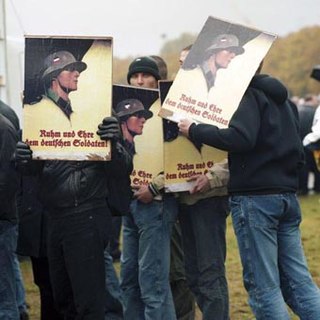
The myth of the clean Wehrmacht is the negationist notion that the regular German armed forces were not involved in the Holocaust or other war crimes during World War II. The myth, heavily promoted by German authors and military personnel after World War II, completely denies the culpability of the German military command in the planning and perpetration of war crimes. Even where the perpetration of war crimes and the waging of an extermination campaign, particularly in the Soviet Union – where the Nazis viewed the population as "sub-humans" ruled by "Jewish Bolshevik" conspirators – has been acknowledged, they are ascribed to the "Party soldiers corps", the Schutzstaffel (SS), but not the regular German military.
The Police Regiment South was a formation of the German Order Police, the German national uniformed police force, during the Nazi era. During Operation Barbarossa, it was subordinated to the Schutzstaffel (SS) and deployed in German-occupied territories, specifically the Army Group South Rear Area. In July 1942, its three constituent battalions were redesignated as the 10th Police Regiment.
The Police Battalion 45 was a formation of the German Order Police during the Nazi era. During Operation Barbarossa, it was subordinated to the SS and deployed in German-occupied areas, specifically the Army Group Centre Rear Area, of the Soviet Union, as part of Police Regiment South. Alongside detachments from the Einsatzgruppen of the SD and the 1st SS Infantry Brigade of the Waffen-SS, it perpetrated mass murder in the Holocaust and was responsible for large-scale crimes against humanity targeting civilian populations.
The Krasnodar Trial was a war crimes trial that was held in front of a military tribunal in July 1943 in Krasnodar, Soviet Union. All of the defendants were Soviets who collaborated with Germany. All 11 defendants were accused of treason for collaborating with the Nazi German military, police and SS forces, which were responsible for implementing the occupational policies during the German–Soviet War (1941–1945). The trial was the first war crimes trial of World War II.
The Kharkov Trial was a war crimes trial held in front of a Soviet military tribunal in December 1943 in Kharkov, Soviet Union. Defendants included one Soviet collaborator, as well as German military, police, and SS personnel responsible for implementing the occupational policies during the German–Soviet War of 1941–45. The trial was the first time that German personnel had been tried for war crimes by the Allies during and after World War II.
{{cite web}}: Missing or empty |title= (help)